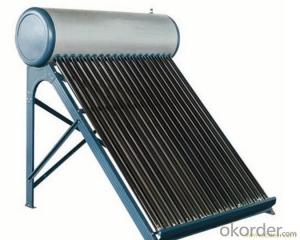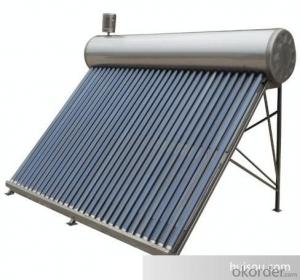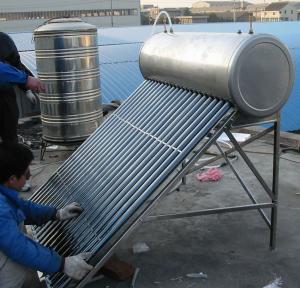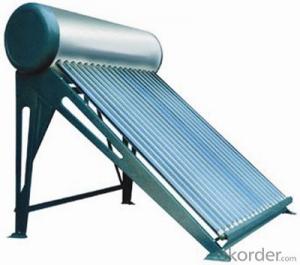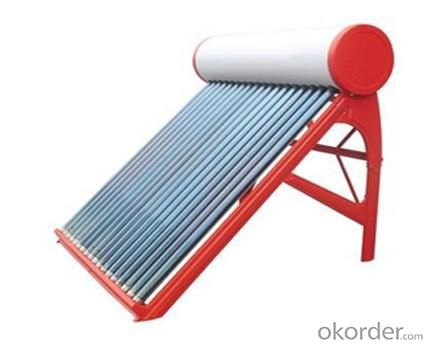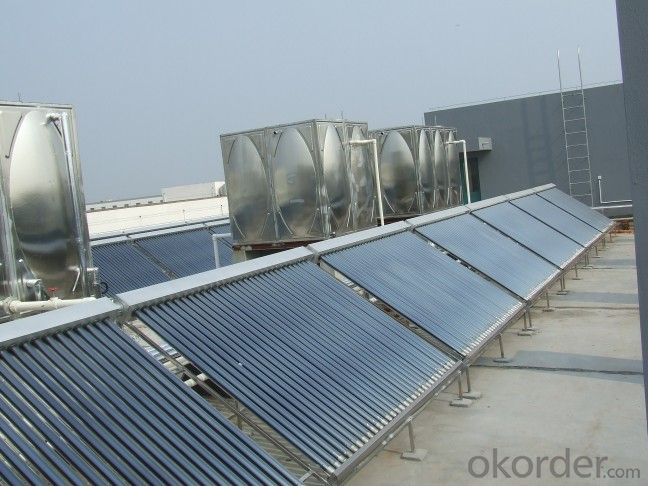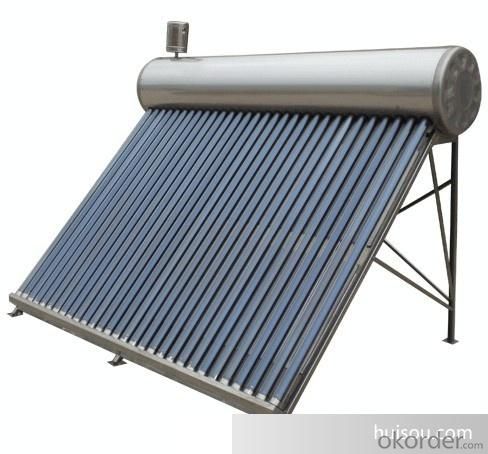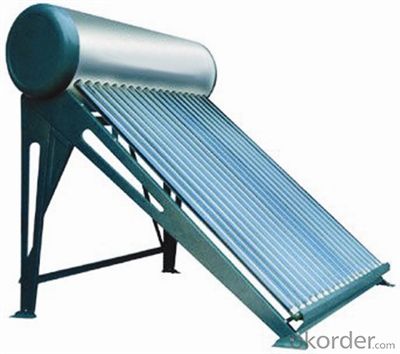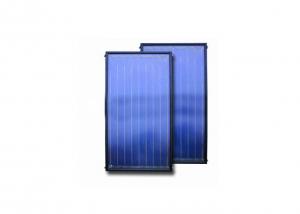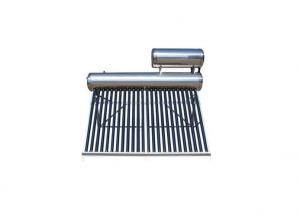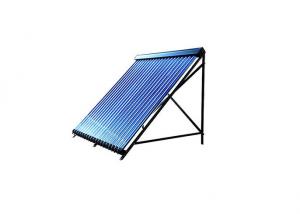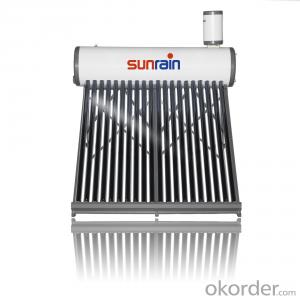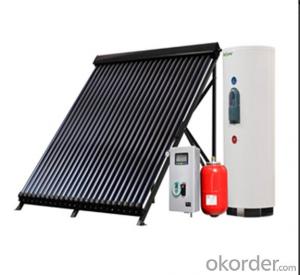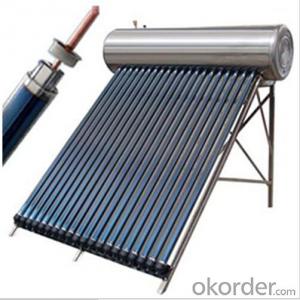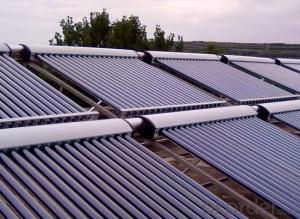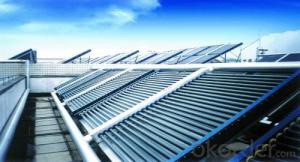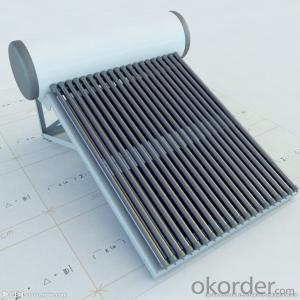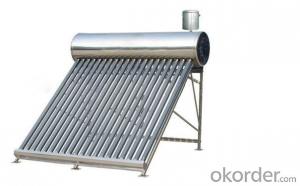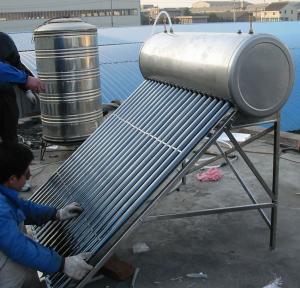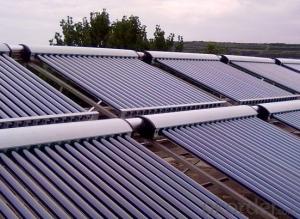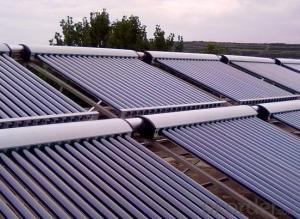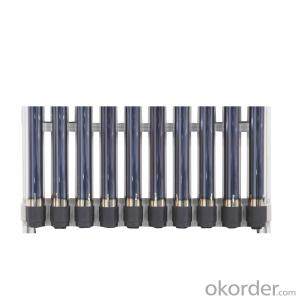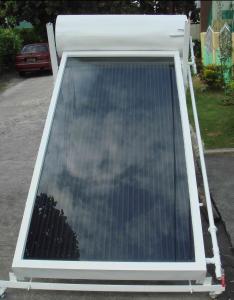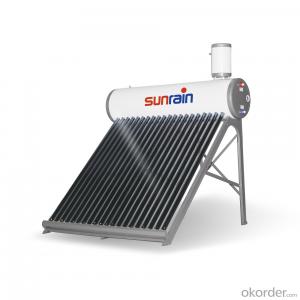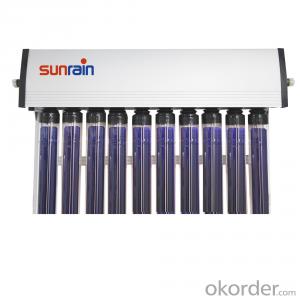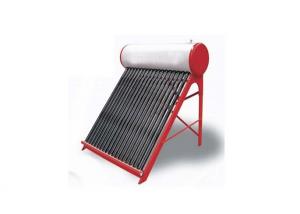Vacuum Tube for Solar Water Heater - 28 Tube Solar Collector China Top Supplier
- Loading Port:
- China main port
- Payment Terms:
- TT OR LC
- Min Order Qty:
- 10 set
- Supply Capability:
- 10000 set/month
OKorder Service Pledge
OKorder Financial Service
You Might Also Like
Introduction of Non-Pressure Solar Water Heater:
Non-pressure Solar Heater is one of the most economical solar water heating device with pretty high efficiency at the same time. It consists of hot water storage tank, solar vacuum tubes with mouth plug in storage tank, and bracket supporting tank and tubes.When cold water in evacuated tubes is heated with solar irradiation, as the specific gravities of hot water and cold water are different, hotter water goes upward to storage tank and colder water goes downward to glass tubes. through this continuous circulation, the cold water in storage tank will be gradually heated till sunset.
Solar water heaters working principle
1. The solar collector absorbs solar energy and transmits it to the solar water heater tank through circulation
2. When the temperature of the collector reaches the set value, the controller starts the circulation pump automatically
3. The circulation pump makes heat-conducting liquid circulate automatically
4. The heat-conducting liquid transfers heat to water by lower heat exchanger in the water tank.
5. When the temperature difference between solar collector and heat pipe solar water heaters tank doesn't reach the set value, the circulation pump will be shut automatically
6. In case the temperature of the water tank does not reach Tmax, Electric Heating Element will start to work automatically
Solar water heaters working station component:
1. Operating screen
2. Manometer
3. Pump speed adjust switches
4. Temperature difference circulation pump
5. Flow rate indicator
Solar water heaters specification:
Description | solar water heaters |
Material of out manifold | 0.55mm thickness color steel/ fluorine carbon steel |
Material of inner tank | Food grade 2.0 mm thickness SUS304 stainless steel |
Tank insulating layer | 40mm 45kg/m³ high-density polyurethane foamed |
Inlet and outlet hole | Male G1'' |
Max pressure | 0.6 Mpa |
Solar collector tube | 3.3 Borosilicate glass with N/Al coating |
Thickness of glass tube | 1.6mm |
Vacuum tube tightness | P≤0.005 Pa |
Absorption | as=0.93-0.96 (AM1.5) |
Emission ratio | εh=0.04-0.06 (80C±5C) |
Idle sunning property parameters | Y=220~260m2.C/KW |
Average heat loss coefficient | ULT=0.6~0.7W/(m2.C) |
Bracket: | 2.0mm thickness aluminum alloy |
Tank weight | 75KGS |
Tank size | 560mm Dia x 1810mm Height |
Tank capacity | 300L |
Solar collector | 2pcs 58x1800x15tube solar collector |
Absorber area | 2.811 m² |
Working station | SP116 working station |
Heat exchanger length | Upper:12m, Underside:18m |
Solar water heaters details show:
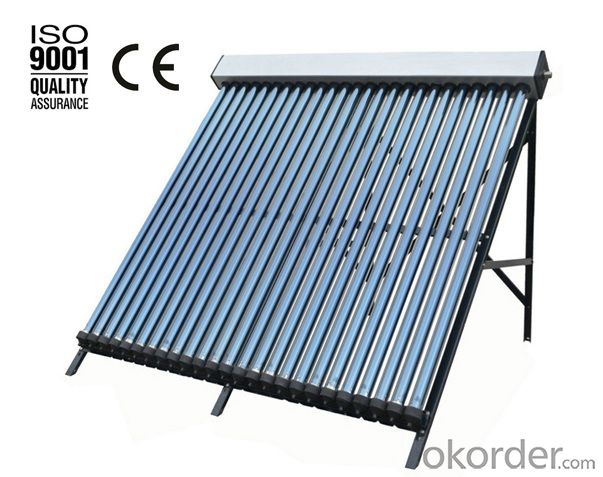
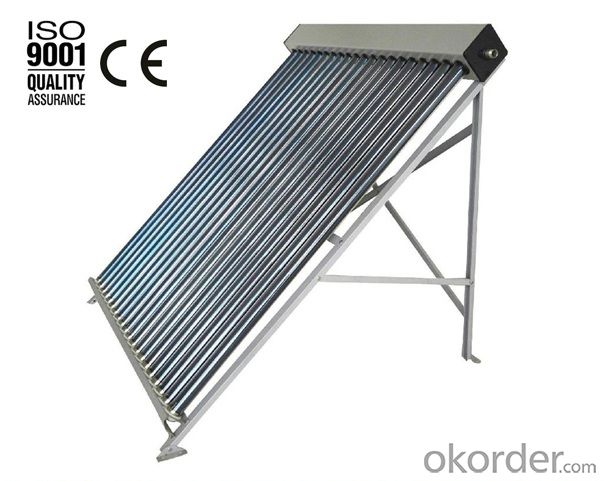
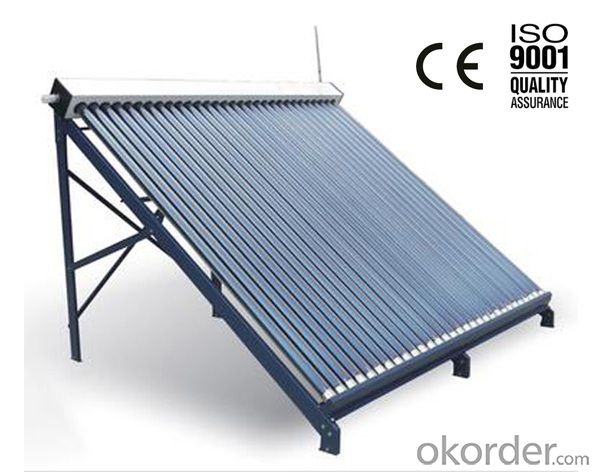
Benefits of this kind of solar water heaters:
1. Prolong the life of your existing water heater
2.Costs less than an electric, gas or oil water heater
3.No maintenance required
4.Lasts longer than a traditional hot water heater
5.Reduce your water heating costs
- Q: How does a solar water heater impact the aesthetics of a property?
- A solar water heater can have a positive impact on the aesthetics of a property by reducing the need for large conventional water heating systems, such as bulky water tanks or boilers. Solar water heaters are typically more compact and can be integrated into the architecture of a building more easily. Their sleek and modern design can also enhance the overall appearance of a property, contributing to a more environmentally-friendly and visually appealing aesthetic.
- Q: TMC navigation solar water heater how to use intelligent instruments, water flashing. Show constant water level, pressure, these 2 did not flash, Sheung Shui flashing, the temperature of 15 degrees.. No hot water。。。 How to set
- Timing mode: can be set two times water, the timing of the heating time, the original factory set the timing of the first water 9:00 water level to 100%, the second 15:00 start to the water level of the water level of 100%. Timed heating, heating 4:00 to 50 DEG C for the first time, heating 16:00 to 50 DEG C for the first time. The user can set the time and parameters to meet the individual needs of usersControl mode: when the water in the water tank is not full, the water temperature is higher than the temperature of water temperature set by the user (the original factory set to 60 DEG C) automatic water below the appropriate water temperature control temperature of 10 DEG C, this function can prevent the unreasonable phenomenon of low water and high water temperature. When the water (water level changes), the delay of 60 minutes to start, in order to avoid the user is starting water when water. Several times the temperature control function time: 8:00-17:00. This mode does not automatically start the electric heating, the user can choose manual heating according to the needs, this model is the most energy-efficient.
- Q: What is the difference between an active and passive solar water heater?
- An active solar water heater utilizes pumps or fans to circulate the water or heat transfer fluid, while a passive solar water heater relies on natural convection or thermosiphon to circulate the water.
- Q: In the market to see the next, solar energy is also a lot of brands are also many. Look, what kind of solar energy is good?
- In addition, there is a kind of pressure bearing solar energy, water pressure, water more, as if it can automatically Sheung Shui, convenient.When you buy, you can consider these aspects, I believe you can buy a satisfactory solar energy.
- Q: Solar water heater is good
- When heating without water pump pressure; continuous cloudy water temperature is not enough when you need to start the electric heating; in fact, the structure of the solar water heater is very simple, relatively easy to trouble only electronic pump. Now most of the whole machine is guaranteed 1-3 years, heat collection tube for 5 years;
- Q: Can a solar water heater be used in areas with limited access to training programs?
- Yes, a solar water heater can be used in areas with limited access to training programs. Solar water heaters are relatively simple and straightforward to install and operate, requiring minimal technical knowledge. Additionally, manufacturers often provide detailed installation instructions and user manuals to assist with the setup and maintenance. In case of any difficulties, online resources and tutorials can be accessed to address any issues or questions. Therefore, limited access to training programs should not hinder the use and effectiveness of a solar water heater in such areas.
- Q: Are there different types of solar water heaters?
- Yes, there are different types of solar water heaters. Some common types include passive solar water heaters, active solar water heaters, and batch solar water heaters. These types vary in terms of their designs, installation methods, and how they heat and store water using solar energy.
- Q: Is it possible to retrofit an existing water heater with solar panels?
- Indeed, it is plausible to equip an already existing water heater with solar panels. The process of retrofitting a water heater with solar panels entails the installation of a solar thermal system that harnesses the sun's energy to warm the water. This can be accomplished by situating solar panels on the rooftop or in an area that receives optimal sunlight exposure, and linking them to the current water heater via a network of pipes and valves. The solar panels accumulate the sun's energy and transfer it to a fluid, commonly a blend of water and antifreeze, which courses through the panels. As the fluid is heated by the sun, it is then channeled to a heat exchanger within the pre-existing water heater, where it imparts the heat to the water stored in the tank. Consequently, this procedure significantly diminishes the energy required to heat the water, thereby leading to reduced energy expenses and a more environmentally-friendly solution. Retrofitting a pre-existing water heater with solar panels can prove to be economical since it utilizes the already established infrastructure. Nonetheless, it is crucial to consider the age and condition of the water heater, as older or inefficient models may not be suitable for solar retrofitting. Additionally, the availability of roof space or area for solar panel installation should be evaluated to ensure maximum exposure to sunlight. It is advisable to consult a professional solar installer or an HVAC technician experienced in solar retrofitting to assess the viability and compatibility of the current water heater for integration with solar panels. They can provide expert advice on the most suitable approach, equipment requirements, and potential financial incentives or tax credits that may be accessible for such retrofit projects.
- Q: What are the common safety precautions for installing a solar water heater?
- Some common safety precautions for installing a solar water heater include wearing protective gear such as gloves, goggles, and a mask, ensuring proper electrical grounding and wiring, following manufacturer's instructions and guidelines, turning off power supply before installation, avoiding working in adverse weather conditions, and seeking professional assistance if unsure about any aspect of the installation process.
- Q: A sun rain licensing solar water heater manual electric heating, overflow, can not automatically stop Sheung Shui, what is the reason?
- Two. Solenoid valve failure. The probability of such a failure is not equal to that of the probe. Determine the way: the instrument power off, then the tank also continues to overflow, and then turn off the solenoid valve before the cold water, then, the water tank stopped. In this way, you can determine the solenoid valve failure. The solution is to replace the solenoid valve.Three. The cold and hot water mixing valve of hot and cold water communication. The probability of such failure is not much, but there are also. The judgment way: the instrument power off, then the water tank water inlet switch off, then continue to overflow, the first tank hot water outlet is closed, then the tank does not overflow, then you can judge the fault reason of mixing valve. As long as the failure of the mixed valve can be replaced.
Send your message to us
Vacuum Tube for Solar Water Heater - 28 Tube Solar Collector China Top Supplier
- Loading Port:
- China main port
- Payment Terms:
- TT OR LC
- Min Order Qty:
- 10 set
- Supply Capability:
- 10000 set/month
OKorder Service Pledge
OKorder Financial Service
Similar products
Hot products
Hot Searches
Related keywords
